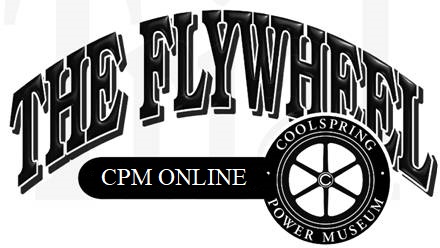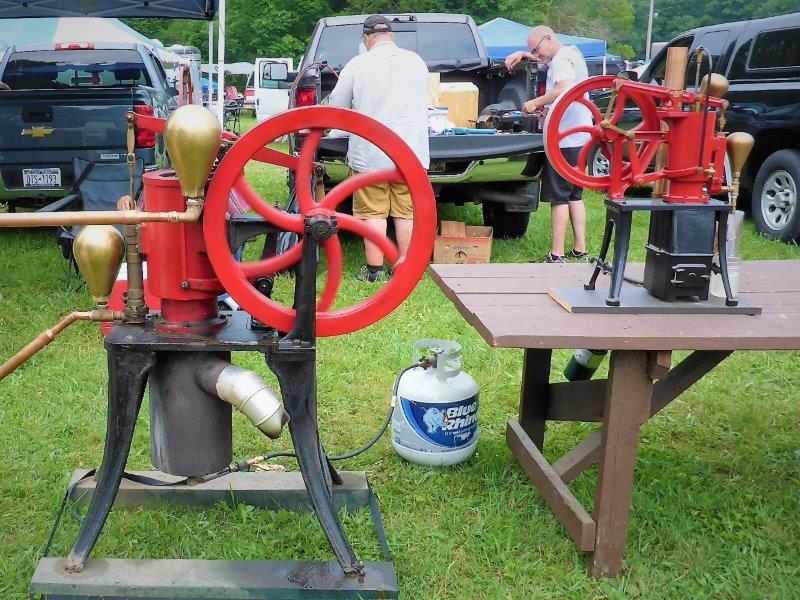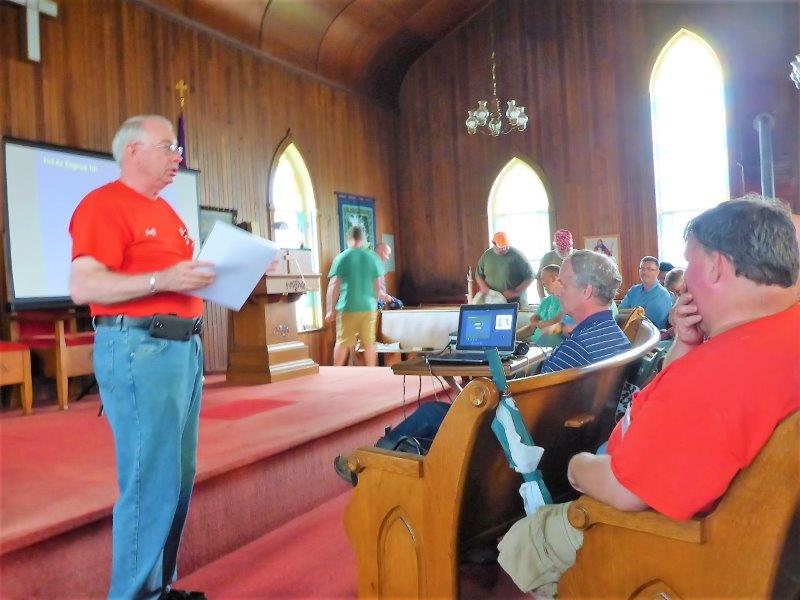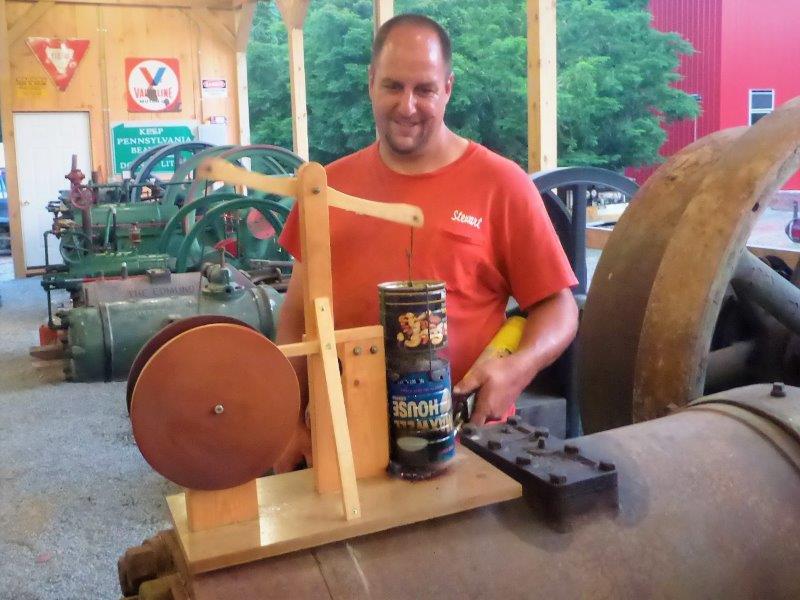
July-August 2017
June Show Report
By Paul Harvey
There is only one way to describe the museum's recent show: FANTASTIC!!!! We were blessed with great weather, having only a couple of typical Coolspring showers during the night. The days were sunny and bright, without our typical mud. Our guests, as well as the staff, seemed relaxed and ready to have a great experience. A record attendance enjoyed the show, yet it did not seem crowded. There was an abundance of museum engines in operation along with wonderful exhibits and displays, food, flea market, and, most importantly, genuine fellowship.
For this show, the museum displayed a unique niche of engines: the hot air engines. Although Coolspring is dedicated to the internal combustion engine, these unique machines are external combustion, obtaining the needed heat from a firebox outside of the cylinder. We were delighted to be introduced to another group of collectors who specialize in these most interesting engines. They certainly responded enthusiastically to our event by providing one of the largest hot air engine displays ever assembled. On Friday morning, two of our volunteers made a count of the number of hot air engines displayed and were astonished to find 197. The count included 37 hot air engine-driven fans, 60 original engines, and 100 toys and models. Better yet, so many new friendships were formed as the museum gained a deep appreciation of these machines.
I photographed many of these engines and will present some for the reader to enjoy. Please forgive me if I missed a certain engine or have it incorrectly represented.
When I was relieved from my gate duty about 2 p.m. on Thursday, I decided to take my camera and tour the many exhibits. The first hot air engine that I encountered was this little Philips engine and generator. Note Photo 1. These neat little units were built in the 1950s and aimed at the camping industry which was blossoming as the country recovered from World War II. They could provide 200 watts of electricity absolutely silently. Photo 2 depicts a very complicated Thomas & Smith hot air engine pumping water that was cascading over the "plants" in the background. The linkage was fascinating to view in operation.
Moving to another aisle, I found this Ericsson-style pumping engine built by the American Machine Company of Newark, Delaware. It is seen in Photo 3. A bit farther along, I found this unique toy engine display, noted in Photo 4. It appears to be an Ernst Planck vintage toy hot air engine operating a model machine shop. A very intriguing demonstration. Just outside the Earle T. Harvey Memorial Exposition Hall was this Rider-style hot air pumping engine burning wood as fuel. See Photo 5. A surprisingly small fire kept it operating quite happily.
There was a great display of hot air engines inside the Earle T. Harvey Memorial Exposition Hall. Tables were full of small engines, with larger ones on the surrounding floor. Most were running - to our guests' delight. This Jost fan, Photo 6, is just one example. What a great display!
Back outside, I saw this Ericsson-style Slocomb engine made in Wilmington, Delaware, and depicted in Photo 7. Close by, Photo 8, were two more Ericsson-style engines, a "real" one and a fantastic model. Yet another Ericsson-style engine is seen in Photo 9. These displays just had to be seen!
As evening approached, many of us headed for the Coolspring Presbyterian Church as we anticipated a great lecture. Our speaker was Dr. Brent Rowell who graciously authored this year's Bores & Strokes issue; The Rider-Ericsson Engine Co., A Short History. Brent is well known as one of the leading hot air engine enthusiasts in the country. Photo 10 depicts our show co-chairman Kieth Monnier giving the introduction. About 85 persons attended. I wish we could have so many on Sundays. Photo 11 shows Brent giving his great lecture accompanied with slides. It was a great day.
Friday I again returned to the display area to see what I had missed, and it was so much. Photo 12 is another Rider-style engine burning wood. Notice the stove pipe chimney to provide draft to keep the fire burning. Seen in Photo 13 is an interesting Bremen engine, made in Bremen, Ohio. It departs from the usual Rider and Ericsson designs but still uses the Stiring cycle. They certainly shared their place with all the other hot air engines. In the next row, I saw this rather large homemade hot air engine. It was very well done and I had to look at the tag to make sure it was not factory. Note Photo 14. It was built by J.E. Lancaster and restored by John White. The design was unique and it ran flawlessly.
The Preston Foster Hall had some wonderful hot air engine displays. There was a china cabinet full of small engines as well as tables, display cases, and larger ones on the floor. Photo 15 and Photo 16 are just a hint at what was included. It was a mixture of toy engines, old engines, and new engines, all skillfully placed to view.
It just seems appropriate to conclude this article with Photo 17 showing a smiling Stewart McKinley running the "tin can" engine built by his mentor, the late Dale Haugh. Dale was a master mechanic and one of the founding members of the original "Coolspring Hit & Miss Engine Society" which was formed in 1976. That smile sums up the entire show!!
I am now writing The Flywheel articles on a bimonthly basis, and the next one will be the September-October issue. In anticipation of the museum featuring Oil Field Engines for the June 2018 show, I will give the reader a glimpse of our Either engine. This oil field engine can run on either gas or steam. Hope you enjoy it.

Photo 1: Philips engine and generator

Photo 2: Thomas & Smith hot air engine

Photo 3: Ericsson-style pumping engine built by the American Machine Company

Photo 4: Ernst Planck toy engine and model machine shop

Photo 5: Rider-style engine fueled by wood

Photo 6: Jost fan

Photo 7: Slocomb engine

Photo 8: Ericsson-style engine and model engine

Photo 9: Ericsson-style engine

Photo 10: Kieth Monnier introducing the speaker

Photo 11: Dr. Brent Rowell

Photo 12: Rider-style engine

Photo 13: Bremen engine

Photo 14: Homemade engine by J.E. Lancaster, restored by John White

Photo 15: Engine display in Preston Foster Hall

Photo 16: Engine display in Preston Foster Hall

Photo 17: Stewart McKinley and "tin can" engine